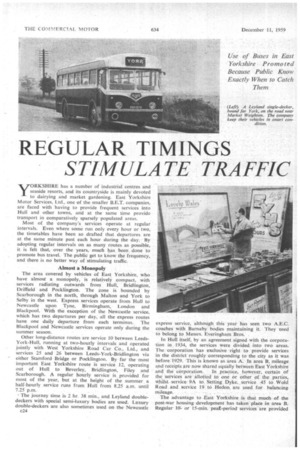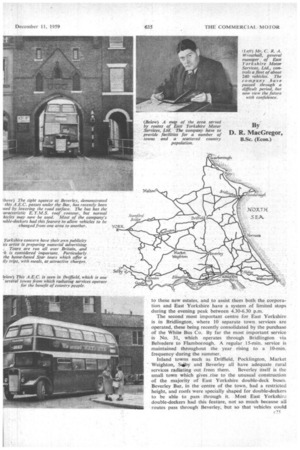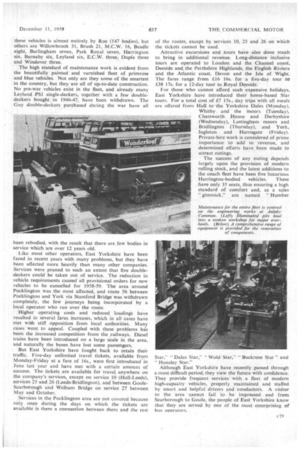REGULAR TIMINGS STIMULATE TRAFFIC
Page 60

Page 61

Page 62

Page 65

If you've noticed an error in this article please click here to report it so we can fix it.
By D. R. MacGregor, B.Se. (Econ.)
yORKSHIRE has a number of industrial centres and seaside resorts, and its countryside is mainly devoted to dairying and market gardening. East Yorkshire Motor Services, Ltd., one of the smaller B.E.T. companies, are faced with having to provide frequent services into Hull and other towns, and at the same time provide transport in comparatively sparsely populated areas.
Most of the company's services operate at regular intervals. Even where some run only every hour or two, the timetables have been so drafted that departures are at the same minute past each hour during the day. By adopting regular intervals on as many routes as possible, it is felt that, over the years, much has been done to promote bus travel. The public get to know the frequency, and there is no better way of stimulating traffic.
Almost a Monopoly
The area covered by vehicles of East Yorkshire, who have almost a monopoly, is relatively compact, with services radiating outwards from Hull, Bridlington, Driffield and Pocklington. The zone is bounded by Scarborough in the north, through Mahon and York to Selby in the west. Express services operate from Hull to Newcastle upon Tyne, Birmingham, London and Blackpool. With the exception of the Newcastle service, which has two departures per day, all the express routes have one daily departure from each terminus. The Blackpool and Newcastle services operate only during the summer season.
Other long-distance routes are service 10 between LeedsYork-Hull, running at two-hourly intervals and operated jointly with West Yorkshire Road Car Co., Ltd., and services 25 and 26 between Leeds-York-Bridlington via either Stamford Bridge or Poeklington. By• far the most important East Yorkshire route is service 12, operating out of Hull to Beverley, Bridlington, Filey and Scarborough. A regular hourly service is provided for most of the year, but at the height of the summer a half-hourly service runs from Hull from 8.25 a.m. until 7.25 p.m. .
• The journey time is 2 hr. 38 min., and Leyland doubledeckers with special semi-luxury bodies are used. Luxury double-deckers are also sometimes used on the Newcastle c24
express-. service, although this yearhas seen two A.E.C. coaches with. Barn aby bodies maintaining it. They used to belong to Messrs. Everingham Bros.
In Hull itself, by an agreement signed -with the corporation in 1934, the services were divided into two areas. The corporation has exclusive right • to 'provide services in the district roughly corresponding to the city as it was before 1929. This is known as area. AlIn area R, mileage and receipts are now Shared equally betWeen East Yorkshire and the corporation., In practice, _however, certain of the services are allotted .to one or other of. the .parties, . service. 9A to. Setting.. Dyke, ,service .45 to . Wold Road. and. service 19. to -Hedon, are .used for balancing The advantage to .East Yorkshire is: that much of the post-war housing-development has taken "place in area B. Regular. 10: or .15-min.peat-period .serVices are provided
to these new estates, and to assist ,them both the corporation and East Yorkshire have a system of limited stops during the evening peak between 4.30-6,30 p.m.
The second most important centre for East Yorkshire is in Bridlington, where 10 separate town services are operated, these being recently consolidated by the purchase of the White Bus Co. By far the most important service is No. 31, which operates through Bridlington via Belvedere to Flamborough. A regular 15-mM. service is maintained throughout the year rising to a 10-min. frequency during the summer.
Inland towns such as Driffield, Pocklington, Market Weighton, Sby and Beverley all have adequate rural services radiating out from them. Beverley itself is the small town which gives ,rise to the unusual construction of the majority of East Yorkshire double-deck buses. Beverley Bar, in the centre of the town, had a restricted height, and roofs were specially shaped for double-deckers to be able to pass through it. Most East Yorkshire double-deckers had this feature, not so much because all routes pass through Beverley, but so that 'vehicles could he switched from one area to another it traffic demands changed. Now that the road has been altered, ordinary vehicles may be used. • Within the past few .years the services of Messrs. Everingham Bros., radiating out of Pocklington have been acquired, and this has done much to give East Yorkshire
a near monopoly of stage services within that area with all its resultant economies.
The main depot and head office of the concern are in Anlaby Road, Hull. The garage faces one of the main routes into Hull, and is close enough to Ferensway coach station, the main departure point for all services in Hull, for dead mileage to be reduced to a minimum. The garage is equipped with an Essex. bus washing machine and pits for routine maintenance, all heavy repairs being carried
out some distance away at the engineering works. at Anlaby Common.
Beside the garage is a large Victorian villa which serves as the company's head office, and from outward appearances, at least, is unpretentious compared with the two new depots recently built at Elioughton and Pocklington. These two buildings are well designed, with small contemporary inquiry offices beside them and reflect a progressive policy. Another recent improvement has been the construction of a coach station at Scarborough for the heavy summer traffic each year. East Yorkshire depots are also at Bridlington, Driffield, Hornsea, Withernsea and York.
Anlaby Common engineering works is the central point for the entire maintenance of the fleet. Until a few years ago, all docking was carried out at the depots at which the vehicles were based, but now all overhauls are done at Anlaby Common. Additional pits have been constructed and the
works enlarged. The advantage of centralized overhaul is that each depot is now able to concentrate on the day-today work, also that it is possible to make full use of modern equipment. The latest Hartridge apparatus is used in the injection-pump. room. A Crypton electrical test bench and a brake-lining machine have been installed..
Vehicle docks are to generally accepted standards with alternate inspection routines' at 20,000-mile intervals and Major examination at 100,000 miles. At 200,000 miles, a complete major overhaul takes place. All main units are replaced, although experiments are continually being carried out to extend these fixed mileages. This exacting maintenance system is shown to the best advantage in the light of the fleet's fuel-consumption average of 13 m.p.g.—this with 88-per-cent. double-decker mileage.
With the drop in traffic, the fleet,. which stood at 264 vehicles in 1958, is being reduced to about 240. On last year's figures, it was composed of 171 double-deckers and 93 single-deckers. The chassis for these. are: Leyland, 204; A.E.C., 29; Guy, 22; Leyland-Beadle, eight; Albion, one.
For many years, apart from the Guys which were obtained. during thewar, the fleet was almost wholly Leyland. In fact, the eight Leyland-Beadle coaches are semi-chassisless. types which were built in 1951 with running units from
pre-war Leyland TD models. .
A.E.C. vehicles have been introduced recently and have proved so satisfactory that an order for 20 Bridgemasters has been placed for delivery next year. The lone Albion chassis is a special one-man-operated Aberdonian singledecker based at Pocklington depot. Coachwork on
these vehicles is almost entirely by Roe (147 bodies), but others are Willowbrook 31, Brush 21, M.C.W. 16, Beadle eight, Burlingham seven, Park Royal seven, Harrington six, Barnaby six, Leyland six, E.C.W. three, Duple three and Windover three.
The high standard of maintenance work is evident from the beautifully painted and varnished fleet of primrose and blue vehicles. Not only are they some of the smartest in the country, but they are all of up-to-date construction. No pre-war vehicles exist in the fleet, and already many Leyland PS1 single-deckers, together with a few doubledeckers bought in 1946-47, have been withdrawn. The Guy double-deckers purchased during the war have all been rebodied, with the result that there are few bodies in service which are over 12 years old.
Like most other operators, East Yorkshire have been faced in recent years with many problems, but they have been affected more heavily than many other companies. Services were pruned to such an extent that five doubledeckers could be taken out of service. The reduction in vehicle requirements caused all provisional orders for new vehicles to be cancelled for 1958-59. The area around Pocklington was the most -affected, and route .56 between Pocklington and York via Stamford Bridge was withdrawn completely, the few journeys being incorporated by a local operator who ran over the route.
Higher operating costs and reduced loadings have resulted in several fares increases, which in all cases have met with stiff opposition from local authorities. Many cases went to appeal. Coupled with these problems hg's been the increased competition from the railways. Diesel trains have been introduced on a large scale in the area, and naturally the buses have lost some passengers.
But East Yorkshire have fought back to retain their traffic. Five-day unlimited travel tickets, available from Monday-Friday at a fare of 16s., were first introduced in June last year and have met with a certain amount of success. The tickets are available for travel anywhere on the company's services, except on service 10 (Hull-Leeds), services 25 and 26 (Leeds-Bridlington), and between GooleScarborough and Welham Bridge on service 27 between May and October.
Services in the Pocklington area are not covered because only once during the days on which the tickets are available is there a connection between there and the rest of the routes, except by services 10, 25 and 26 on which the tickets cannot be used.
Attractive excursions and tours have also done much to bring in additional revenue. Long-distance inclusive tours are operated to London and the Channel coast, Deeside and, the Perthshire Highlands, the English Riviera and the Atlantic coast, Devon and the Isle of Wight. The fares range from £16 16s. for a five-day tour to £38 17s. for a 12-day tour to Royal Deeside.
For those who cannot afford such -expensive holidays, East Yorkshire have introduced their home-based Star tours. For a total cost of £7 15s.; day trips with all meals are offered from Hull to'the Yorkshire Dales (Monday), Whitby and the moors (Tuesday), Chatsworth House and Derbyshire (Wednesday), Lastingharn moors and Bridlington (Thursday), and York, Ingleton and Harrogate (Friday). Private-hire work is considered of prime importance to add to revenue, and determined efforts have been made to attract outings.
The success of any outing depends largely upon the provision of modern rolling stock, and the latest additions to the coach fleet have been five luxurious Harrington-bodied vehicles. These have only 35 seats, thus ensuring a high standard of comfort and, as a sales "gimmick." are named "Humber
Star.Dales Star," " Wold Star," " Buckrose Star and Hunsley Star."
Although East Yorkshire have recently passed through a most difficult period, they view the future with confidence. They provide frequent services with a fleet of modern high-capacity vehicles, properly maintained and staffed
• by smart and helpful drivers and conductors. A visitor to •the area cannot fail to be impressed and from Scarborough to Goole, the people of East Yorkshire know that they are served by one of the most enterprising of bus operators.
























































































































